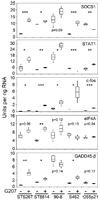Molecular analysis of human cancer cells infected by an oncolytic HSV-1 reveals multiple upregulated cellular genes and a role for SOCS1 in virus replication
- PMID: 18551144
- PMCID: PMC2852536
- DOI: 10.1038/cgt.2008.40
Molecular analysis of human cancer cells infected by an oncolytic HSV-1 reveals multiple upregulated cellular genes and a role for SOCS1 in virus replication
Abstract
Oncolytic herpes simplex viruses (oHSVs) are promising anticancer therapeutics. We sought to characterize the functional genomic response of human cancer cells to oHSV infection using G207, an oHSV previously evaluated in a phase I trial. Five human malignant peripheral nerve sheath tumor cell lines, with differing sensitivity to oHSV, were infected with G207 for 6 h. Functional genomic analysis of virus-infected cells demonstrated large clusters of downregulated cellular mRNAs and smaller clusters of those upregulated, including 21 genes commonly upregulated in all five lines. Of these, 7 are known to be HSV-1 induced and 14 represent novel virus-regulated genes. Gene ontology analysis revealed that a majority of G207-upregulated genes are involved in Janus kinase/signal transducer and activator of transcription signaling, transcriptional regulation, nucleic acid metabolism, protein synthesis and apoptosis. Ingenuity networks highlighted nodes for AP-1 subunits and interferon signaling via STAT1, suppressor of cytokine signaling-1 (SOCS1), SOCS3 and RANTES. As biological confirmation, we found that virus-mediated upregulation of SOCS1 correlated with sensitivity to G207 and that depletion of SOCS1 impaired virus replication by >10-fold. Further characterization of roles provided by oHSV-induced cellular genes during virus replication may be utilized to predict oncolytic efficacy and to provide rational strategies for designing next-generation oncolytic viruses.
Conflict of interest statement
The authors have no conflicting financial interests.
Figures





Similar articles
-
Malignant peripheral nerve sheath tumors with high and low Ras-GTP are permissive for oncolytic herpes simplex virus mutants.Pediatr Blood Cancer. 2006 Jun;46(7):745-54. doi: 10.1002/pbc.20565. Pediatr Blood Cancer. 2006. PMID: 16124003
-
Molecular engineering and validation of an oncolytic herpes simplex virus type 1 transcriptionally targeted to midkine-positive tumors.J Gene Med. 2010 Jul;12(7):613-23. doi: 10.1002/jgm.1479. J Gene Med. 2010. PMID: 20603890
-
Combination Therapy Using Ruxolitinib and Oncolytic HSV Renders Resistant MPNSTs Susceptible to Virotherapy.Cancer Immunol Res. 2018 Dec;6(12):1499-1510. doi: 10.1158/2326-6066.CIR-18-0014. Epub 2018 Oct 23. Cancer Immunol Res. 2018. PMID: 30352799
-
Oncolytic HSV: Underpinnings of Tumor Susceptibility.Viruses. 2021 Jul 20;13(7):1408. doi: 10.3390/v13071408. Viruses. 2021. PMID: 34372614 Free PMC article. Review.
-
Replication and Spread of Oncolytic Herpes Simplex Virus in Solid Tumors.Viruses. 2022 Jan 10;14(1):118. doi: 10.3390/v14010118. Viruses. 2022. PMID: 35062322 Free PMC article. Review.
Cited by
-
Effect of Repeat Dosing of Engineered Oncolytic Herpes Simplex Virus on Preclinical Models of Rhabdomyosarcoma.Transl Oncol. 2016 Oct;9(5):419-430. doi: 10.1016/j.tranon.2016.07.008. Transl Oncol. 2016. PMID: 27751346 Free PMC article.
-
Assessment of oncolytic HSV efficacy following increased entry-receptor expression in malignant peripheral nerve sheath tumor cell lines.Gene Ther. 2014 Nov;21(11):984-90. doi: 10.1038/gt.2014.72. Epub 2014 Aug 14. Gene Ther. 2014. PMID: 25119379 Free PMC article.
-
UBR5 in Tumor Biology: Exploring Mechanisms of Immune Regulation and Possible Therapeutic Implications in MPNST.Cancers (Basel). 2025 Jan 7;17(2):161. doi: 10.3390/cancers17020161. Cancers (Basel). 2025. PMID: 39857943 Free PMC article. Review.
-
HTLV-1 evades type I interferon antiviral signaling by inducing the suppressor of cytokine signaling 1 (SOCS1).PLoS Pathog. 2010 Nov 4;6(11):e1001177. doi: 10.1371/journal.ppat.1001177. PLoS Pathog. 2010. PMID: 21079688 Free PMC article.
-
Lack of strong anti-viral immune gene stimulation in Torque Teno Sus Virus1 infected macrophage cells.Virology. 2016 Aug;495:63-70. doi: 10.1016/j.virol.2016.04.028. Epub 2016 May 11. Virology. 2016. PMID: 27179346 Free PMC article.
References
-
- Lin E, Nemunaitis J. Oncolytic viral therapies. Cancer Gene Ther. 2004;11:643–664. - PubMed
-
- Bell JC. Oncolytic viruses: what’s next? Curr Cancer Drug Targets. 2007;7:127–131. - PubMed
-
- Shen Y, Nemunaitis J. Herpes simplex virus 1 (HSV-1) for cancer treatment. Cancer Gene Ther. 2006;7:7. - PubMed
-
- Aghi M, Martuza RL. Oncolytic viral therapies—the clinical experience. Oncogene. 2005;24:7802–7816. - PubMed
-
- Aghi M, Rabkin S, Martuza RL. Effect of chemotherapy-induced DNA repair on oncolytic herpes simplex viral replication. J Natl Cancer Inst. 2006;98:38–50. - PubMed
Publication types
MeSH terms
Substances
Grants and funding
LinkOut - more resources
Full Text Sources
Other Literature Sources
Molecular Biology Databases
Research Materials
Miscellaneous

